数据结构——顺序队列
【摘要】 队列的顺序
用一维数组base[M]
空队标志: front = rear入队:base[rear++] = x出队:x = base[front++]
存在的问题
front ≠ 0 rear = M时, 假溢出
解决方法——循环队列
实现:利用模运算 入队: base[rear] = x; rear = (rear+1) % M;...
队列的顺序
- 用一维数组base[M]
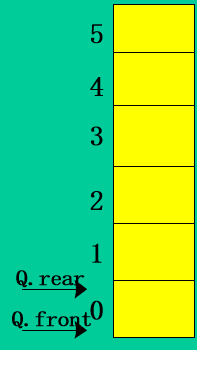
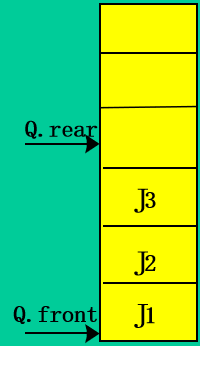
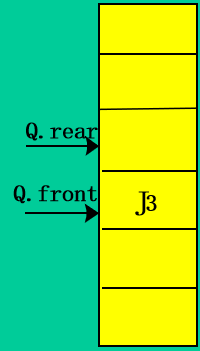

- 空队标志: front = rear
- 入队:base[rear++] = x
- 出队:x = base[front++]
存在的问题
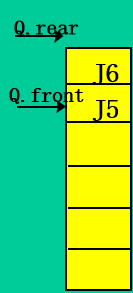
front ≠ 0
rear = M时,
假溢出
解决方法——循环队列
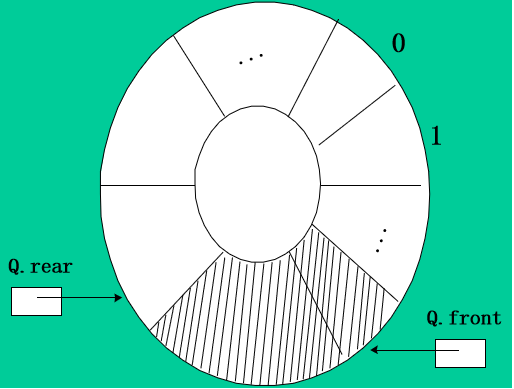
- 实现:利用模运算
- 入队:
base[rear] = x;
rear = (rear+1) % M; - 出队:
x = base[front];
front = (front + 1) % M;
- 入队:
C++代码实现
#include<iostream>
#include<stdlib.h>
using namespace std;
#define OK 1
#define ERROR -1
#define OVERFLOW -2
typedef int Status;
typedef int QElemType;
#define MAXSIZE 100 // 最大长度
/*------------静态分配------------*/
//typedef struct {
// QElemType elem[MAXSIZE];
// QElemType* rear; // 队尾指针
// QElemType* front; // 队头指针
// int length; // 长度
//}SqQueue;
/*------------动态分配------------*/
typedef struct {
QElemType* elem; // 动态分配存储空间初始化
int rear; // 尾指针
int front; // 头指针
}SqQueue;
// 构造空队列
Status InitSqQueue(SqQueue& Q) {
Q.elem = new QElemType[MAXSIZE];
if (!Q.elem) exit(OVERFLOW);
Q.front = Q.rear = 0;
return OK;
}
// 队列长度
int QueueLength(SqQueue Q) {
return(Q.rear - Q.front) % MAXSIZE;
}
// 判断队列是否为空
bool IsSqQueueEmpty(SqQueue Q) {
return Q.rear == Q.front;
}
// 判断队列是否满
bool IsSqQueueFull(SqQueue Q) {
return (Q.rear + 1) % MAXSIZE == Q.front;
}
// 入队
Status PushSqQueue(SqQueue& Q, QElemType e) {
if (IsSqQueueFull(Q)) return ERROR;
Q.elem[Q.rear] = e;
Q.rear = (Q.rear + 1) % MAXSIZE;
return OK;
}
// 出队
Status PopSqQueue(SqQueue& Q, QElemType &e) {
if (IsSqQueueEmpty(Q)) return ERROR;
e = Q.elem[Q.front];
Q.front = (Q.front + 1) % MAXSIZE;
return OK;
}
// 创建队列
void CreatSqQueue(SqQueue& Q, int m) {
QElemType e;
for (int i = 1; i <= m; i++) {
cout << "请输入第" << i << "个元素的值: ";
cin >> e;
PushSqQueue(Q, e);
}
}
// 输出队列
void OutPut(SqQueue Q) {
int i;
i = Q.front;
while (i != Q.rear) {
cout << Q.elem[i] << " ";
i = (i + 1) % MAXSIZE;
}
cout << endl;
}
int main()
{
// 测试代码
SqQueue Q;
QElemType e;
int m;
InitSqQueue(Q);
cout << "请输入队列的长度: ";
cin >> m;
CreatSqQueue(Q, m);
OutPut(Q);
cout << "队列的长度为: " << QueueLength(Q) << endl;
cout << "请输入入队元素: ";
cin >> e;
PushSqQueue(Q, e);
cout << "队列元素为: ";
OutPut(Q);
cout << "队列的长度为: " << QueueLength(Q) << endl;
PopSqQueue(Q, e);
cout << "出队元素为: " << e << endl;
cout << "队列元素为: ";
OutPut(Q);
cout << "队列的长度为: " << QueueLength(Q) << endl;
return 0;
}
- 1
- 2
- 3
- 4
- 5
- 6
- 7
- 8
- 9
- 10
- 11
- 12
- 13
- 14
- 15
- 16
- 17
- 18
- 19
- 20
- 21
- 22
- 23
- 24
- 25
- 26
- 27
- 28
- 29
- 30
- 31
- 32
- 33
- 34
- 35
- 36
- 37
- 38
- 39
- 40
- 41
- 42
- 43
- 44
- 45
- 46
- 47
- 48
- 49
- 50
- 51
- 52
- 53
- 54
- 55
- 56
- 57
- 58
- 59
- 60
- 61
- 62
- 63
- 64
- 65
- 66
- 67
- 68
- 69
- 70
- 71
- 72
- 73
- 74
- 75
- 76
- 77
- 78
- 79
- 80
- 81
- 82
- 83
- 84
- 85
- 86
- 87
- 88
- 89
- 90
- 91
- 92
- 93
- 94
- 95
- 96
- 97
- 98
- 99
- 100
- 101
- 102
- 103
- 104
- 105
- 106
- 107
- 108
- 109
- 110
- 111
- 112
- 113
- 114
- 115
- 116
- 117
请输入队列的长度: 3
请输入第1个元素的值: 1
请输入第2个元素的值: 2
请输入第3个元素的值: 3
1 2 3
队列的长度为: 3
请输入入队元素: 4
队列元素为: 1 2 3 4
队列的长度为: 4
出队元素为: 1
队列元素为: 2 3 4
队列的长度为: 3
- 1
- 2
- 3
- 4
- 5
- 6
- 7
- 8
- 9
- 10
- 11
- 12
文章来源: ruochen.blog.csdn.net,作者:若尘,版权归原作者所有,如需转载,请联系作者。
原文链接:ruochen.blog.csdn.net/article/details/102902146
【版权声明】本文为华为云社区用户转载文章,如果您发现本社区中有涉嫌抄袭的内容,欢迎发送邮件进行举报,并提供相关证据,一经查实,本社区将立刻删除涉嫌侵权内容,举报邮箱:
cloudbbs@huaweicloud.com
- 点赞
- 收藏
- 关注作者


评论(0)